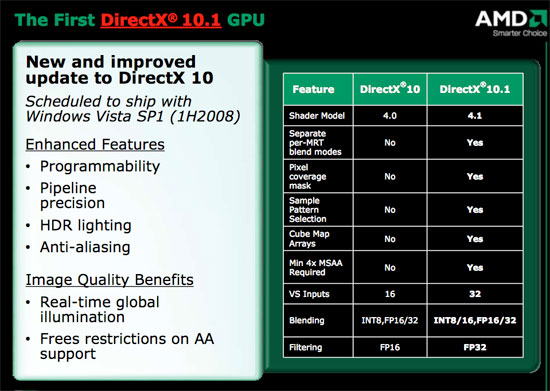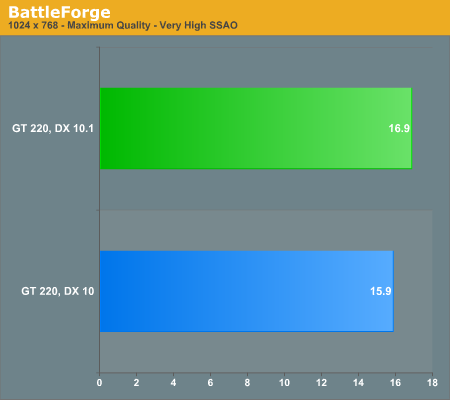NVIDIA’s GeForce GT 220: 40nm and DX10.1 for the Low-End
by Ryan Smith on October 12, 2009 6:00 AM EST- Posted in
- GPUs
DirectX 10.1 on an NVIDIA GPU?
Easily the most interesting thing about the GT 220 and G 210 is that they mark the introduction of DirectX 10.1 functionality on an NVIDIA GPU. It’s no secret that NVIDIA does not take a particular interest in DX10.1, and in fact even with this they still don’t. But for these new low-end parts, NVIDIA had some special problems: OEMs.
OEMs like spec sheets. They want parts that conform to certain features so that they can in turn use those features to sell the product to consumers. OEMs don’t want to sell a product with “only” DX10.0 support if their rivals are using DX10.1 parts. Which in turn means that at some point NVIDIA would need to add DX10.1 functionality, or risk losing out on lucrative OEM contracts.
This is compounded by the fact that while Fermi has bypassed DX10.1 entirely for the high-end, Fermi’s low-end offspring are still some time away. Meanwhile AMD will be shipping their low-end DX11 parts in the first half of next year.
So why do GT 220 and G 210 have DX10.1 functionality? To satisfy the OEMs, and that’s about it. NVIDIA’s focus is still on DX10 and DX11. DX10.1 functionality was easy to add to the GT200-derrived architecture (bear in mind that GT200 already had some DX10.1 functionality), and so it was done for the OEMs. We would also add that NVIDIA has also mentioned the desire to not be dinged by reviewers and forum-goers for lacking this feature, but we’re having a hard time buying the idea that NVIDIA cares about either of those nearly as much as they care about what the OEMs think when it comes to this class of parts.

DX10.1 in a nutshell, as seen in our Radeon 3870 Review
At any rate, while we don’t normally benchmark with DX10.1 functionality enabled, we did so today to make sure DX10.1 was working as it should be. Below are our Battleforge results, using DX10 and DX10.1 with Very High SSAO enabled.

The ultimate proof that DX10.1 is a checkbox feature here is performance. Certainly DX10.1 is a faster way to implement certain effects, but running them in the first place still comes at a significant performance penalty. Hardware of this class is simply too slow to make meaningful use of the DX10.1 content that’s out there at this point.










80 Comments
View All Comments
chizow - Monday, October 12, 2009 - link
Is this the one you're referring to Ryan?http://www.newegg.com/Product/Product.aspx?Item=N8...">http://www.newegg.com/Product/Product.a...E1681412...
From all reports and feedback I've seen, that Asus part is 96SP for $40 AR (was actually $35 at one point!) just as Ben stated.
I don't really care about this segment of parts for actual 3D so you may be right. I was only interested in that Asus 96SP because it was identified by many users as "the card" to get for dedicated PhysX on a budget. I was hoping to find a low-power consumption candidate on 40nm for dedicated PhysX, but it seems these parts have too few SP to be viable.
BenSkywalker - Monday, October 12, 2009 - link
Why not include benches of the nV part that you quoted the price for then(btw- NewEgg is also listing one of the 384MB 96SP 9600GSOs for $56.49)?It is rather misleading to put it mildly that you decide to include benches for one part that is quite a bit cheaper, and quite a bit slower, and then quote the price on the next rung up on the performance ladder. It would be akin to showing benches for the GTX275 and lamenting it because the GTX285 was so expensive, it doesn't make any sense.
Ryan Smith - Monday, October 12, 2009 - link
Which part? The 9600GT, or the 48SP GSO?What you see are all of the low-end cards we were able to get our hands on for this article.
jordanclock - Monday, October 12, 2009 - link
The graphs on the "Temperature and Noise" page are high-to-low. Usually they're the opposite, following the idea that lower numbers are better. I know, I know, it's a lame nitpick.As for the card: If they added this checkbox feature for OEMs (which I believe) then why bother allowing for retail distribution? This card really doesn't bring anything that isn't already done with cards they already have available. Seems like a rather silly release.
Ryan Smith - Monday, October 12, 2009 - link
Fixed. Thanks.jonup - Monday, October 12, 2009 - link
Ryan, the Palit table shows their 1GB card's frame buffer as 512MB.strikeback03 - Monday, October 12, 2009 - link
Seems recently there have been a lot of low-end cards with 1GB of memory onboard. Is this just a marketing ploy, or is there actually some scenario where it would be useful to have lots of memory but not much processing power?Concillian - Monday, October 12, 2009 - link
The 1GB on low end cards is a marketing thing. The "average consumer" equates more memory with performance and generally have little to no knowledge about the importance of GPU type, speed, or graphics memory bandwidth.nVidia and ATi have been taking advantage of this to help add profit margin since at least the GeForce 4 MX generation.
Zingam - Monday, October 12, 2009 - link
This will be one craptastic graphics card for the masses! Yay!Good luck, NVIDIA!
Dante80 - Monday, October 12, 2009 - link
This could have been a killer HTPC card...one year ago.I understand the need for nvidia to come up with sth for this market segment, and I like very much both the improved audio and the low power consumption.
But lets be honest here. This card has no place in the current retail market. It merely looks as a project to max margins for OEM use. OEMs can market a "Brand new card with a smaller process, DX10.1 support and 1 whole GB of memory goodness", but retail vendors and nvidia will have a hard time convincing anyone to buy this instead of going for a 9600 or a 4670.
Since margins seem godly, nvidia should lower the price and try to saturate the market segment with these cards in a HTPC (suicide) mission. That would at least make sense to consumers.